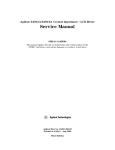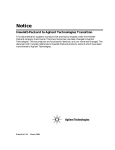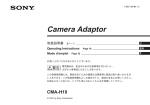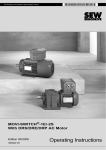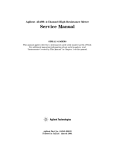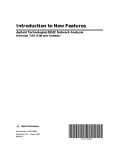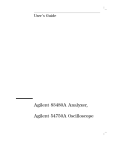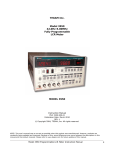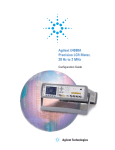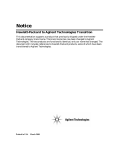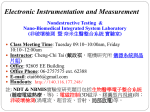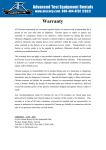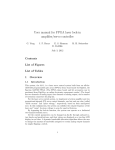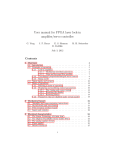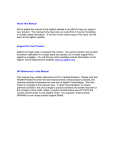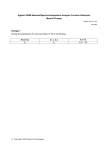Download User Manual - Excalibur Engineering
Transcript
Agilent E4915A Crystal Impedance Meter Agilent E4916A Crystal Impedance/LCR Meter User's Guide SERIAL NUMBERS This manual applies directly to instruments which have the serial number prex JP1KD, or rmware revision 2.1x. For additional important information about serial numbers, read \Serial Number" in Appendix A. Agilent Part No. E4915-90041 Printed in JAPAN February 2001 Seventh Edition c Copyright 1996, 1997, 1998, 2000, 2001 Agilent Technologies Japan, Ltd. Manual Printing History August 1996 : : : : : : : : : : : : : : First Edition (part number: January 1997 : : : : : : : : : : : Second Edition (part number: April 1997 : : : : : : : : : : : : : : : : Third Edition (part number: June 1997 : : : : : : : : : : : : : : Fourth Edition (part number: March 1998 : : : : : : : : : : : : : : : Fifth Edition (part number: March 2000 : : : : : : : : : : : : : : : Sixth Edition (part number: February 2001 : : : : : : : : Seventh Edition (part number: E4915-90001) E4915-90011) E4915-90021) E4915-90031) E4915-90041) E4915-90041) E4915-90041) iii Safety Summary The following general safety precautions must be observed during all phases of operation, service, and repair of this instrument. Failure to comply with these precautions or with specic WARNINGS elsewhere in this manual may impair the protection provided by the equipment. In addition it violates safety standards of design, manufacture, and intended use of the instrument. The Agilent Technologies assumes no liability for the customer's failure to comply with these requirements. Note Note E4915A and E4916A comply with INSTALLATION CATEGORY II and POLLUTION DEGREE 2 in IEC1010-1. E4915A and E4916A are INDOOR USE product. LEDs in this product are Class 1 in accordance with IEC825-1. CLASS 1 LED PRODUCT Ground The Instrument To avoid electric shock hazard, the instrument chassis and cabinet must be connected to a safety earth ground by the supplied power cable with earth blade. DO NOT Operate In An Explosive Atmosphere Do not operate the instrument in the presence of ammable gasses or fumes. Operation of any electrical instrument in such an environment constitutes a denite safety hazard. Keep Away From Live Circuits Operating personnel must not remove instrument covers. Component replacement and internal adjustments must be made by qualied maintenance personnel. Do not replace components with the power cable connected. Under certain conditions, dangerous voltages may exist even with the power cable removed. To avoid injuries, always disconnect power and discharge circuits before touching them. DO NOT Service Or Adjust Alone Do not attempt internal service or adjustment unless another person, capable of rendering rst aid and resuscitation, is present. DO NOT Substitute Parts Or Modify Instrument Because of the danger of introducing additional hazards, do not install substitute parts or perform unauthorized modications to the instrument. Return the instrument to a Agilent Technologies Sales and Service Oce for service and repair to ensure that safety features are maintained. iv Dangerous Procedure Warnings Warnings , such as the example below, precede potentially dangerous procedures throughout this manual. Instructions contained in the warnings must be followed. Warning Dangerous voltages, capable of causing death, are present in this instrument. Use extreme caution when handling, testing, and adjusting this instrument. v Certication Agilent Technologies certies that this product met its published specications at the time of shipment from the factory. Agilent Technologies further certies that its calibration measurements are traceable to the United States National Institute of Standards and Technology, to the extent allowed by the Institution's calibration facility, or to the calibration facilities of other International Standards Organization members. Warranty This Agilent Technologies instrument product is warranted against defects in material and workmanship for a period of one year from the date of shipment, except that in the case of certain components listed in General Information of this manual, the warranty shall be for the specied period. During the warranty period, Agilent Technologies will, at its option, either repair or replace products that prove to be defective. For warranty service or repair, this product must be returned to a service facility designated by Agilent Technologies. Buyer shall prepay shipping charges to Agilent Technologies and Agilent Technologies shall pay shipping charges to return the product to Buyer. However, Buyer shall pay all shipping charges, duties, and taxes for products returned to Agilent Technologies from another country. Agilent Technologies warrants that its software and rmware designated by Agilent Technologies for use with an instrument will execute its programming instruction when property installed on that instrument. Agilent Technologies does not warrant that the operation of the instrument, or software, or rmware will be uninterrupted or error free. Limitation Of Warranty The foregoing warranty shall not apply to defects resulting from improper or inadequate maintenance by Buyer, Buyer-supplied software or interfacing, unauthorized modication or misuse, operation outside the environmental specications for the product, or improper site preparation or maintenance. No other warranty is expressed or implied. Agilent Technologies specically disclaims the implied warranties of merchantability and tness for a particular purpose. vi Exclusive Remedies Assistance The remedies provided herein are buyer's sole and exclusive remedies. Agilent Technologies shall not be liable for any direct, indirect, special, incidental, or consequential damages, whether based on contract, tort, or any other legal theory. Product maintenance agreements and other customer assistance agreements are available for Agilent Technologies products. For any assistance, contact your nearest Agilent Technologies Sales and Service Oce. Addresses are provided at the back of this manual. vii Typeface Conventions Bold Italics Computer HARDKEYS5 4 NNNNNNNNNNNNNNNNNNNNNNNNNN SOFTKEYS viii Boldface type is used when a term is dened. For example: icons are symbols. Italic type is used for emphasis and for titles of manuals and other publications. Italic type is also used for keyboard entries when a name or a variable must be typed in place of the words in italics. For example: copy lename means to type the word copy, to type a space, and then to type the name of a le such as file1. Computer font is used for on-screen prompts and messages. Labeled keys on the instrument front panel are enclosed in 4 5. Softkeys located to the right of the CRT are enclosed in . NNNNN Safety Symbols General denitions of safety symbols used on equipment or in manuals are listed below. Instruction manual symbol: the product is marked with this symbol when it is necessary for the user to refer to the instruction manual. Alternating current. Direct current. On (Supply). O (Supply). In position of push-button switch. Out position of push-button switch. Frame (or chassis) terminal. A connection to the frame (chassis) of the equipment which normally include all exposed metal structures. This Warning sign denotes a hazard. It calls attention to a procedure, practice, condition or the like, which, if not correctly performed or adhered to, could result in injury or death to personnel. This Caution sign denotes a hazard. It calls attention to a procedure, practice, condition or the like, which, if not correctly performed or adhered to, could result in damage to or destruction of part or all of the product. Note denotes important information. It calls attention to a procedure, practice, condition or the like, which is essential to highlight. ix About This Manual Introduction This manual explains about the operation of E4915A Crystal Impedance Meter and E4916A Crystal Impedance/LCR Meter. The manual consists of the following sections: This chapter explains the outline of E4915A and E4916A. Front Panel,Rear Panel,and Display This chapter explains the features of the front and rear panels of the E4915A and E4916A. Installation and Setup Guide This chapter explains points to be checked when the distributed package is opened and the method to setup E4915A and E4916A. Please read this chapter before you set up E4915A and E4916A. Quick Start Guide Applications x This chapter illustrates basic operational procedures. This chapter shows step-by-step instructions to measure a crystal resonator with a PI-xture and other devices. Documentation Guide Please refer to the following manuals for the operation of the analyzer where necessarily. E4915A and E4916A User's Guide This document explains the method to set up and basic operations of E4915A and E4916A in simple steps. E4915A and E4916A Operation Manual This document describes all function accessed from the front panel keys and softkeys, and a summary of all available GPIB commands. It also provides information on options and accessories available, specications, and some topics about the meter's features. Service Manual (Option 0BW only) The Service Manual explains how to adjust, troubleshoot, and repair the instrument. This manual is option 0BW only. xi Contents 1. Introduction Features of the E4915A/E4916A . . . . . . . . . . . . 1-1 2. Front Panel, Rear Panel, and Display Front Panel . . . . . . . . . . . . . . . . . . Display . . . . . . . . . . . . . . . . . . . Character Display Area . . . . . . . . . . . Current Settings ( 9 ) . . . . . . . . . . . . . Comparator Output (Comparator Pass/Fail) LED Rear Panel . . . . . . . . . . . . . . . . . . . . . . . . . . . . . . . . . . 2-1 2-3 2-3 2-3 2-4 2-5 3. Installation and Set Up Guide Incoming Inspection . . . . . . . . . . . . . . . Power Requirements . . . . . . . . . . . . . . . Power Cable . . . . . . . . . . . . . . . . . . Ventilation Requirements . . . . . . . . . . . . . Instruction for Cleaning . . . . . . . . . . . . . . Rack/Handle Installation . . . . . . . . . . . . . Option 1CN Handle Kit . . . . . . . . . . . . . Installing the Handle . . . . . . . . . . . . . Option 1CM Rack Mount Kit . . . . . . . . . . . Mounting the Rack . . . . . . . . . . . . . . Connecting a Probe (E4916A Option 001 Only) . . . . . . . . . . . . . . . . . . . . . . 3-1 3-2 3-2 3-4 3-4 3-5 3-6 3-6 3-7 3-7 3-7 4. Quick Start Guide Overview . . . . . . . . . . . . . . . . . . . . . . Required Equipment . . . . . . . . . . . . . . . . Step 1: Preparing For Measurement . . . . . . . Step 2 : Turning ON the Meter . . . . . . . . . . . . Line Input Receptacle . . . . . . . . . . . . . . . . Fuse . . . . . . . . . . . . . . . . . . . . . Steps To Turn On The Power . . . . . . . . . . . . Step 3 : Setting Up the Meter . . . . . . . . . . . . . Step 4 : Selecting the Measurement Mode . . . . . . . Step 5 : Performing OPEN/SHORT/LOAD Calibrations . . OPEN/SHORT/LOAD Calibration . . . . . . . . . . . Step 6 : Connecting DUT and Reading Measurement Results . . . . . . . . . . . . . . . . . . . . . . If an Error Message Appears When DUT Is Connected If "|-" Appears When DUT Is Connected . . . . . . 4-1 4-2 4-3 4-4 4-4 4-4 4-4 4-5 4-6 4-6 4-6 4-7 4-7 4-8 Contents-1 5. Applications Measuring Crystal Component Characteristics Using PI-Network Test Fixture . . . . . . . . . . . . . . Required Parts and Equipment . . . . . . . . . . . Preparation . . . . . . . . . . . . . . . . . . . . Connecting Fixture . . . . . . . . . . . . . . . . Specifying Measurement Parameters . . . . . . . . . Calibration . . . . . . . . . . . . . . . . . . . . . Equivalent Circuit Analysis . . . . . . . . . . . . . Procedure . . . . . . . . . . . . . . . . . . . . Displaying Analysis Results . . . . . . . . . . . . Measuring Resonant Frequency (FL ) with Capacitive Load Connected . . . . . . . . . . . . . . . . . Target Capacitance trimming Function (CL_a/CL_t) . . Selecting a CL adapter board . . . . . . . . . . . Procedure . . . . . . . . . . . . . . . . . . . . Measuring Spurious Signals . . . . . . . . . . . . . Procedure . . . . . . . . . . . . . . . . . . . . Specifying Spurious Signal Search Range . . . . . Specifying Number of Spurious Signals and Selecting Target Signal . . . . . . . . . . . . Displaying Fr and CI Simultaneously . . . . . . . . High Q Mode . . . . . . . . . . . . . . . . . . . . Procedure . . . . . . . . . . . . . . . . . . . . Delta Mode . . . . . . . . . . . . . . . . . . . . . Specifying Reference CI . . . . . . . . . . . . . . Specifying Reference Frequency . . . . . . . . . . Displaying 1 . . . . . . . . . . . . . . . . . . . Specifying Target Signal Level and Using ALC Function (E4916A Only) . . . . . . . . . . . . . . . . . Specifying Signal Level . . . . . . . . . . . . . . Specifying Nominal CI . . . . . . . . . . . . . . Setting ALC Function . . . . . . . . . . . . . . . Analog Output . . . . . . . . . . . . . . . . . . . Specifying Reference Frequency . . . . . . . . . . Specifying Rate of Change in Output Voltage . . . . Turning Analog Output ON/OFF . . . . . . . . . . Printing . . . . . . . . . . . . . . . . . . . . . . Printers . . . . . . . . . . . . . . . . . . . . . Equipment Required for Printing . . . . . . . . . Connecting Printer . . . . . . . . . . . . . . . . Printing Procedure . . . . . . . . . . . . . . . . Changing Calibration Standard Values When Using PI-Network Test Fixture Other Than 41900A . . . Drive Level Dependency Test (E4916A Only) . . . . . . Procedure . . . . . . . . . . . . . . . . . . . . . Specifying Frequency . . . . . . . . . . . . . . . Specifying Drive Level Sweep Settings . . . . . . . Stopping Measurement In Case Of Faulty Search During Sweep . . . . . . . . . . . . . . . . . Limit Tests . . . . . . . . . . . . . . . . . . . . . Primary and Secondary Parameters . . . . . . . . Tertiary Parameter . . . . . . . . . . . . . . . . Evaporation Monitoring Function (E4916A Only) . . . . Measurement Using Filter (E4916A Only) . . . . . . . . Contents-2 5-1 5-1 5-1 5-1 5-1 5-2 5-2 5-2 5-3 5-3 5-4 5-4 5-5 5-5 5-6 5-6 5-6 5-6 5-7 5-7 5-7 5-7 5-7 5-8 5-8 5-8 5-9 5-9 5-9 5-9 5-9 5-9 5-10 5-10 5-10 5-10 5-11 5-12 5-13 5-13 5-13 5-13 5-15 5-15 5-16 5-16 5-17 5-18 Procedure . . . . . . . . . . . . . . . . . . . . . Selecting Filter Mode . . . . . . . . . . . . . . . Specifying Frequency . . . . . . . . . . . . . . . Specifying Bandwidth . . . . . . . . . . . . . . . Selecting Constant or Minimum Loss . . . . . . . . Displaying Measurement Results . . . . . . . . . . Limit Tests . . . . . . . . . . . . . . . . . . . . . Primary and Secondary Parameters . . . . . . . . Tertiary Parameter . . . . . . . . . . . . . . . . Measuring LCR Using Impedance Probe (E4916A with Options 001 and 010 Only) . . . . . . . . . . . . . Required Equipment . . . . . . . . . . . . . . . . Connection . . . . . . . . . . . . . . . . . . . . . Selecting LCR Mode . . . . . . . . . . . . . . . . Selecting Measurement Circuit . . . . . . . . . . . Selecting Measurement Parameters . . . . . . . . . Measurement Frequency . . . . . . . . . . . . . Averaging . . . . . . . . . . . . . . . . . . . . Voltage and Current Monitor . . . . . . . . . . . Calibrating Probe . . . . . . . . . . . . . . . . . . Measurement . . . . . . . . . . . . . . . . . . . . Measuring LCR Using Test Fixture Adapter (E4916A with Options 001 and 010 Only) . . . . . . . . . . . . . Required Equipment . . . . . . . . . . . . . . . . Selecting Settings and Calibration . . . . . . . . . . Connecting 16099A Test Fixture Adapter . . . . . . . Compensating for Fixture Loss . . . . . . . . . . . Load Compensation . . . . . . . . . . . . . . . . Displaying Measurement Parameters . . . . . . . . . DC Bias Measurement . . . . . . . . . . . . . . . . Connection . . . . . . . . . . . . . . . . . . . . Handler Interface (Built-in Comparator Function; E4916A Only) . . . . . . . . . . . . . . . . . . . . . . . Specifying Comparator Function Settings . . . . . . . Specifying Limits for Primary Parameter . . . . . . Specifying Limits for Secondary Parameter . . . . . Specifying Limits for Tertiary Parameter (during DLD Measurement Only) . . . . . . . . . . . . . . Specifying Comparator Output Settings . . . . . . Turning Comparator Function ON/OFF . . . . . . . A. Manual Changes Introduction . . . . . . . . . . . . . . . . . . . . . Manual Changes . . . . . . . . . . . . . . . . . . . Serial Number . . . . . . . . . . . . . . . . . . . . 5-18 5-18 5-19 5-19 5-19 5-19 5-19 5-19 5-19 5-21 5-21 5-21 5-21 5-21 5-21 5-22 5-22 5-22 5-22 5-23 5-24 5-24 5-24 5-24 5-24 5-24 5-25 5-25 5-26 5-27 5-28 5-28 5-28 5-29 5-29 5-29 A-1 A-1 A-2 B. Replacing the Fuse Index Contents-3 Figures 2-1. 2-2. 2-3. 2-4. 2-5. 2-6. 3-1. 3-2. 3-3. 4-1. 4-2. 4-3. 4-4. 4-5. 4-6. 5-1. 5-2. 5-3. 5-4. 5-5. 5-6. 5-7. 5-8. 5-9. 5-10. A-1. B-1. Front Panel of E4915A . . . . . . . Front Panel of E4916A . . . . . . . LCD Display . . . . . . . . . . . . E4915A/E4916A LED . . . . . . . . Rear Panel (E4915A) . . . . . . . . Rear Panel (E4916A) . . . . . . . . Power Cable Supplied . . . . . . . . Rack Mount Kits Installation . . . . Connecting a Probe . . . . . . . . . Required Equipment . . . . . . . . Connection of Measurement Cables . Line Input Receptacle and Fuse . . . OPEN/SHORT/LOAD calibration . . . Connecting DUT . . . . . . . . . . Measurement Result Display . . . . . Equivalent Circuit Analysis . . . . . Inserting the CL adapter board . . . Connecting Printer and Converter . . Sweep Type . . . . . . . . . . . . Example of DLD Measurement Result Drive Level Dependency Test . . . . Parameters That Can Be Obtained . . Connecting the Filter . . . . . . . . Connecting DC Bias Power Source . . Sequential and Tolerance Modes . . . Serial Number Plate . . . . . . . . Replacing the Fuse . . . . . . . . . . . . . . . . . . . . . . . . . . . . . . . . . . . . . . . . . . . . . . . . . . . . . . . . . . . . . . . . . . . . . . . . . . . . . . . . . . . . . . . . . . . . . . . . . . . . . . . . . . . . . . . . . . . . . . . . . . . . . . . . . . . . . . . . . . . . . . . . . . . . . . . . . . . . . . . . . . . . . . . . . . . . . . . . . . . . . . . . . . . . . . . . . . . . . . . . . . . . . . . . . . . . . . . . . . . . . . . . . 2-1 2-1 2-3 2-4 2-5 2-5 3-3 3-6 3-8 4-2 4-3 4-4 4-6 4-7 4-7 5-2 5-3 5-11 5-14 5-15 5-16 5-18 5-18 5-26 5-27 A-2 B-1 Tables 1-1. 3-1. 3-2. 5-1. Comparison Between E4915A and E4916A Functions . 1-1 E4915A/E4916A Contents . . . . . . . . . . . . . . 3-2 Rack Mount Kits . . . . . . . . . . . . . . . . . . 3-5 Calibration Standard Values for Agilent PI-Network Test Fixture . . . . . . . . . . . . . . . . . . . . . 5-12 A-1. Manual Changes by Serial Number . . . . . . . . . . A-1 A-2. Manual Changes by ROM Version . . . . . . . . . . A-1 Contents-4 1 Introduction This user's guide describes basic operation procedures for the E4915A/E4916A; ranging from power-on and setup to CI measurement. This guide also shows how to access functions available with the E4915A/E4916A. This guide is intended to serve as a reference for beginning users of the E4915A Crystal Impedance Meter or E4916A Crystal Impedance/LCR Meter. Features of the E4915A/E4916A The E4915A Crystal Impedance Meter and E4916A Crystal Impedance/LCR Meter employ the network analyzer method (transmission network method) to determine performance of crystal resonators. With a built-in receiver similar to that of a network analyzer and a wide measurement range between 1 to 180 MHz, these meters can measure and display parameters that are generally measured for crystal resonators; resonant frequency Fr , crystal impedance CI, and equivalent cirucuit constant. In addition to the basic measurement functions of the E4915A, the E4916A can change the measurement signal level. It also oers the drive level dependency testing as well as the evaporation monitoring, LCR measurement, and analysis using lter. The E4916A can also make measurements using the optional probe 001. The following list shows the dierence between the E4915A and E4916A. Table 1-1. Comparison Between E4915A and E4916A Functions Function Measurement Signal Output 1 to 100 MHz 100 to 180 MHz Drive Level Dependency Testing Evaporation Monitoring Measurement Using Filter (Insertion loss, -xdB bandwidth) LCR Measurement Impedance Probe Internal Comparator E4915A E4916A 05 dBm 060 to +18 dBm 05 dBm 060 to +16 dBm No No Yes Option 010 Option 001 Yes No No No Yes Yes Yes Introduction 1-1 2 Front Panel, Rear Panel, and Display Front Panel Figure 2-1. Front Panel of E4915A Figure 2-2. Front Panel of E4916A 1. Display - Displays measurement results, instrument status, and messages. Front Panel, Rear Panel, and Display 2-1 2. LINE Switch - Turns E4915A/E4916A ON/OFF 3. SOURCE port (E4915A only) - Outputs test signal. This terminal will be connected to a test xture. (E4916A provides this port on the rear panel.) INSTALLATION CATEGORY I 4. TEST port (E4915A only) - Inputs test signal. This terminal will be connected to a test xture. (E4916A provides this port on the rear panel.) 5. Comparator Pass/Fail LED - Shows limit test results (Pass=Acceptable, Fail=Not Acceptable) using the comparator function. 6. 4Trig5 key - Trigger Key 7. Setting Key block - The keys in this block are used to specify functions available with the E4915A/E4916A. 8. Unit key - The keys in this block are use to set the unit of each measurement parameter. 9. Entry key block - The keys in this block is used to input numerical data. 10. Arrow keys - Pressing 4* )5 displays measurement items (softkeys) on the previous page. Pressing 4( +5 displays those on the next page. You can also use these keys to move to the desired choice when there are 2 or more choices available. 11. Select keys - Two (2) select keys are provided. Pressing the upper select key selects the measurement parameter shown in the upper section of the LCD. Pressing the lower key select the parameter in the lower section. 2-2 Front Panel, Rear Panel, and Display Display The E4915A/E4916A has a LCD on the front panel that displays characters over 2 lines. Figure 2-3. LCD Display Character Display Area This area displays setting menus, Measurement Settings, and messages. Current Settings ( 9 ) Each 9 indicates the currently selected setting. The following shows the meaning of each label: 1. Measurement Mode - Shows the measurement mode 2. Calibration (E4915A) or Compen and Cal (E4916A) - Shows the calibration/compensation setting 3. Meas Time - Shows the measurement time setting 4. Trigger - Shows the trigger mode setting Front Panel, Rear Panel, and Display 2-3 Comparator On - Shows the comparator is ON Mem ON - Shows the memory buer function is ON Rmt ON - Shows the GPIB remote mode is ON Key Lock - Shows the key lock is ON Shift - Shows the shift key (4(blue)5) has been pressed and the shift function (blue label on top of key) is available. 10. Measurement Settings - Shows 2 parameters at a time. These parameters can be selected with the top and bottom 4Select5 keys. Pressing 4* )5 and 4( +5 with no parameter selected allows the previous and next pages to be displayed, respectively. These parameters are called softkeys. 9 does not appear in this area. 5. 6. 7. 8. 9. Comparator Output (Comparator Pass/Fail) LED Figure 2-4. E4915A/E4916A LED 1. LED1 - For primary sorting of the primary measurement parameter actual value on the LCD screen using the comparator function, this LED turns ON depending on the result, \Pass" or \Fail." 2. LED2 - For secondary sorting of the secondary measurement parameter actual value on the LCD screen using the comparator function, this LED turns ON depending on the result, \Pass" or \Fail." 3. LED3 - (E4916A Only) For the 1F/1CI limit test or BW test using the tertiary sorting of the comparator function, this LED turns ON depending on the result, \Pass" or \Fail." 2-4 Front Panel, Rear Panel, and Display Rear Panel Figure 2-5. Rear Panel (E4915A) Figure 2-6. Rear Panel (E4916A) 1. Handler Interface Connector - Connects to an external handler. 2. EXT REF Input - Inputs an external reference signal. 3. EXT Trigger Input - Inputs an external signal to trigger a measurement. 4. GPIB Interface - Connects the meter to an external controller for control through GPIB. Front Panel, Rear Panel, and Display 2-5 5. Power Cable Receptacle with Fuse Holder - This is input for the main power cable. 6. Serial Number Plate - Shows the serial number of this unit. 7. Analog Output - Outputs measurement result as analog signal. 8. TEST Port (E4916A only) - Inputs the test signal. This port and the SOURCE port connect to the xture. (E4915A has the test port on the front panel.) INSTALLATION CATEGORY I . 0 dBm,625 Vdc Input Max. 9. REFERENCE Port (E4916A only) - This port is used to connect the impedance probe to the E4916A. INSTALLATION CATEGORY I . +20 dBm,625 Vdc Input Max. 10. Frame or Chassis Terminal (E4916A only) - GND terminal 11. SOURCE Port (E4916A only) - Outputs test signal. This terminal and the TEST terminal connect to the xture. (E4915A has the SOURCE port on the front panel.) 2-6 Front Panel, Rear Panel, and Display 3 Installation and Set Up Guide This chapter provides the information necessary for performing an incoming inspection and setting up the E4915A/E4916A. The main topics in this chapter are: Incoming Inspection Power requirements Ventilation Requirements Instruction for Cleaning Rack/Handle Installation Connecting a Probe (E4916A Option 001 only) Incoming Inspection Warning To avoid hazardous electrical shock, do not turn on the E4915A/E4916A when there are signs of shipping damage to any portion of the outer enclosure (for example, covers, panel, or display) Inspect the shipping container for damage. If the shipping container or cushioning material is damaged, it should be kept until the contents of the shipment have been checked for completeness and the E4915A/E4916A has been checked mechanically and electrically. The contents of the shipment should be as listed in Table 3-1. If the contents are incomplete, if there is mechanical damage or defect, or if the analyzer does not pass the power-on selftests, notify the nearest Agilent Technologies oce. If the shipping container is damaged, or the cushioning material shows signs of unusual stress, notify the carrier as well as the Agilent Technologies oce. Keep the shipping materials for the carrier's inspection. Installation and Set Up Guide 3-1 Table 3-1. E4915A/E4916A Contents Description Qty. Agilent Part Number E4915A/E4916A Power cable1 1 | Program disk set 1 E4915-18010 Operation Manual 1 E4915-90040 User's Guide 1 E4915-90041 2 8120-1838 2 8120-1840 1 E4915-90100 1 5063-9241 1 5063-9226 30 cm BNC Leads2 120 cm BNC Leads3 Option 0BW Add Service Manual Service Manual Option 1CM Rack Mount Kit Rack mount kit Option 1CN Front Handle Kit Front handle kit Option 001 Add Impedance Probe Kit Impedance Probe 1 1 Power Cable depends on where the instrument is used, see \Power Cable". 2 E4915A only 3 E4916A only Power Requirements Power Cable Warning 3-2 Installation and Set Up Guide The E4915A/E4916A requires the following power source: Voltage : 90 to 132 Vac, 198 to 264 Vac Frequency : 47 to 63 Hz Power : 150 VA maximum In accordance with international safety standards, this instrument is equipped with a three-wire power cable. When connected to an appropriate ac power outlet, this cable grounds the instrument frame. The type of power cable shipped with each instrument depends on the country of destination. Refer to Figure 3-1 for the part numbers of the power cables available. For protection from electrical shock, the power cable ground must not be defeated. The power plug must be plugged into an outlet that provides a protective earth ground connection. Figure 3-1. Power Cable Supplied Installation and Set Up Guide 3-3 Ventilation Requirements To ensure adequate ventilation, make sure that there is adequate clearance of at least 250 mm behind, 100 mm on the sides and 15 mm above and below. Instruction for Cleaning To prevent electrical shock, disconnect the E4915A/E4916A power cable from the receptacle before cleaning. Use a dry cloth or a cloth slightly dipped in water to clean the casing. Do not attempt to clean the E4915A/E4916A internally. 3-4 Installation and Set Up Guide Rack/Handle Installation The analyzer can be rack mounted and used as a component in a measurement system. Figure 3-2 shows how to rack mount the E4915A/E4916A. Table 3-2. Rack Mount Kits Option Description Agilent Part Number 1CN Handle Kit 5063-9226 1CM Rack Mount Kit 5063-9241 Installation and Set Up Guide 3-5 Figure 3-2. Rack Mount Kits Installation Option 1CN Handle Kit Option 1CN is a handle kit containing a pair of handles and the necessary hardware to attach them to the instrument. Installing the Handle 1. Remove the adhesive-backed trim strips 1 from the left and right front sides of the E4915A/E4916A. (Refer to Figure 3-2.) 2. Attach the front handles 2 to the sides using the screws provided. 3. Attach the trim strips 3 to the handles. 3-6 Installation and Set Up Guide Option 1CM Rack Mount Kit Option 1CM is a rack mount kit containing a pair of anges and the necessary hardware to mount them to the instrument in an equipment rack with 482.6 mm (19 inches) horizontal spacing. Mounting the Rack 1. Remove the adhesive-backed trim strips 1 from the left and right front sides of the E4915A/E4916A. (Refer to Figure 3-2.) 2. Attach the rack mount ange 4 to the left and right front sides of the E4915A/E4916A using the screws provided. 3. Remove all four feet 5 (lift bar on the inner side of the foot, and slide the foot toward the bar.) Connecting a Probe (E4916A Option 001 Only) 1. Connect the terminal of the probe to the rear panel as shown in the following gure. 2. Connect the white cable of the probe to the REFERECE terminal on the rear panel. 3. Connect the black cable of the probe to the TEST terminal on the rear panel. Installation and Set Up Guide 3-7 Caution 3-8 Installation and Set Up Guide Figure 3-3. Connecting a Probe Make sure that the test signal level is 0 dBm or lower when using the probe. For more information, refer \EMC" in chapter 9 of Operation Manual. 4 Quick Start Guide In this chapter, you will learn how to make basic Fr and CI measurement using the E4915A/E4916A. Overview This chapter describes how to make basic Fr and CI measurement in the following steps. 1. Preparing for measurement Connecting peripherals 2. Turning ON the meter 3. Setting up the meter Selecting the function Selecting the measurement parameter Setting the frequency and search range 4. Performing OPEN/SHORT/LOAD calibrations 5. Connecting DUT and reading measurement results (Fr and CI) Quick Start Guide 4-1 Required Equipment To follow all the steps in this chapter, the following equipment is required: E4915A or E4916A 41900A PI-Network Test Fixture BNC cable x 2 Shorting device 50- load (50- resistor) DUT Figure 4-1. Required Equipment 4-2 Quick Start Guide Step 1: Preparing For Measurement Note E4915A has the SOURCE port and TEST port on the front panel. E4916A has the SOURCE port and TEST port on the rear panel. Connect the SORUCE port to the PI-network test xture with a BNC cable. Connect the TEST port to the PI-network test xture with a BNC cable. Figure 4-2. Connection of Measurement Cables Quick Start Guide 4-3 Step 2 : Turning ON the Meter Figure 4-3. Line Input Receptacle and Fuse Line Input Receptacle Fuse The AC Power cable is connected to this receptacle. Use the following fuse: Agilent Part Number : 2110-038 (UL/CSA type, time delay 3 A 250 Vac) If you need this fuse, contact your nearest Agilent Technologies Sales and Service Oce. Steps To Turn On The Power 1. Connect the AC power cable to the line input receptacle 2. Turn on the E4915A/E4916A (you need 10 minutes for warming up). 3. Press 4(blue)5 4. (Reset)5 to preset the meter. 4-4 Quick Start Guide Step 3 : Setting Up the Meter To measure CI, you need to specify the approximate resonant frequency (nominal frequency) of the resonator to be measured and the frequency range in which to search for the resonance point. 1. Sequentially press 4Freq5, 425, 405, and 4/M5 to specify 20 MHz as the nominal frequency. 2. Then, press the lower Select key (Select key beside RNG :nnnnn ) to specify the search range. ( nnnnn shows the current setting.) NNNNNNNNNNNNNNNNNNNNNNNNNNNNNNNN NNNNNNNNNNNNNNNNN 3. Sequentially press 455, 405, 405, and 4n/ppm5 to specify the search range. With the E4916A, you can also specify the level of test signal to be applied to the resonator. To specify this level, you need to specify the approximate CI of the resonator to be measured. Follow the steps below. Note The signal level specied with the E4916A indicates the power actually applied to a resonator. However, when you specify dBm as the unit of the signal level, the specied level shows the signal level at the port of the E4916A instead of the power applied to a resonator. 1. Sequentially press 4Level5, 415, 405, 405, and 4/M5. (When the test signal level is set at 100 w.) 2. Sequentially press 4Nominal CI5, 425, 405, and 4Enter5. (When CI is set at 20 ) Note With the E4915A, the output power level is xed at 05 dBm. Therefore, you cannot specify the test signal level or CI. Quick Start Guide 4-5 Step 4 : Selecting the Measurement Mode 1. Select the Fr measurement mode. 2. Press 4Meas Prmtr5 to display the following: Param: Fs Fr Fa FL FLtrim 3. Select Fr. Step 5 : Performing OPEN/SHORT/LOAD Calibrations OPEN/SHORT/LOAD Calibration 1. Connect no device to the test xture terminals so that the circuit of the xture is open. 2. Sequentially press 4(blue)5 and 44 (OPEN)5. 3. Wait for a few seconds until the calibration is complete. When the beeper sounds, connect the shorting device to the xture. 4. Sequentially press 4(blue)5 and 45 (SHORT)5 to start the short-circuit calibration. 5. Wait for a few seconds until the calibration is complete. When the beeper sounds, remove the shorting device from the xture. 6. Connect a 50- load (50 resistor) to the xture. 7. Sequentially press 4(blue)5 and 46(LOAD)5. 8. Wait for a few seconds until the LOAD calibration is complete. When the beeper sounds, remove the 50- load from the xture. Figure 4-4. OPEN/SHORT/LOAD calibration 4-6 Quick Start Guide Step 6 : Connecting DUT and Reading Measurement Results An error message appears when no DUT is connected. When the DUT is connected to the xture, the E4915A/E4916A starts searching for the resonance point and then displays the resonant frequency and CI. Figure 4-5. Connecting DUT d c a Fr: 19.4567891MHz CI:24.93 k FREQ:20.000MHz Xtl 999 RNG : 500ppm b Figure 4-6. Measurement Result Display If an Error Message Appears When DUT Is Connected If an error message appears when the DUT is connected, the DUT resonant frequency may not be found within the specied frequency range or calibrations may not have been correctly performed. Check your measurement according to the following guidelines. For more information on each error message, refer to E4915A/E4916A Operation Manual. Check that the nominal DUT resonant frequency matches the frequency you have specied. If these frequencies do not match, repeat the procedure from step 4. If these frequencies match, expand the search range and repeat the procedure from step 4. Reduce the measurement speed. Quick Start Guide 4-7 The crystal resonator may be unable to respond quickly enough to the current measurement speed. To reduce the measurement speed, press 4Meas Time5 and select Long. To further reduce the measurement speed, press HI Q:OFF and turn ON the High Q mode. Measurement speed is the highest with Short and becomes lower in descending order as follows: Short 7 Medium 7 Long 7 High Q NNNNNNNNNNNNNNNNNNNNNNNNNN short 7 High Q Medium 7 High Q Long Decrease the step frequency for serching. Decrease the step frequency for searching the resonant frequency. Reducing the measurement speed decreases the step frequency automatically. If the error message still displays after reducing the measurement speed, you could change the step frequency individually. To decrease the step frequency, use 4*)5 or 4(+5 to display STEP . Then, select STEP and specify the desired value of the step frequency using the keys of the ENTRY block. NNNNNNNNNNNNNN Note Note If NNNNNNNNNNNNNN For the range of the step frequency, refer to the chapter 4 of the E4915A/E4916A Operation Manual. The High Q mode is also useful when measurement values do not settle into a steady state. In such cases, turn ON the High Q mode and reduce measurement speed. "|-" Appears When DUT Is Connected Check that INT (internal trigger) is selected for trigger mode. Sequentially press 4(Blue)5 and 4Trig (Trigger Mode)5 to display a screen where you can specify the trigger mode. Check that INT is ashing and press 4Enter5. If MAN or EXT is ashing, use 4*)5 or 4(+5 to select INT and press 4Enter5. 4-8 Quick Start Guide 5 Applications Measuring Crystal Component Characteristics Using PI-Network Test Fixture This chapter describes the steps of the following measurements using the E4915A and the PI-Network Test Fixture . Equivalent circuit analysis FL measurement Spurious measurement Drive level dependency measurement Evaporation monitoring function Measurement using lter Although the E4915A is used as an example, you can follow the same measurement steps with the E4916A. Required Parts and Equipment The following is required for this measurement: E4915A(or E4916A) 41900A PI-Network Test Fixture 1 CL adapter board (supplied with the 41900A. A capacitive load of 10 pF is used in this measurement.) 2 BNC cables (supplied with the 41900A) Shorting device (supplied with the 41900A) 50 load (supplied with the 41900A) Crystal resonator (target component; A 20-MHz crystal resonator is used in this measurement.) Preparation Connecting Fixture Connect the PI-Network Test Fixture to the E4915A. (See Chapter 4 for how to connect the xture.) Specifying Measurement Parameters 1. Specify 20 MHz as the nominal frequency of the crystal resonator. 4Freq5 425 405 4/M5 2. Specify the range in which to search for the resonant frequency. Press 4(Lower select)5 rst to enter the search range as the deviation from the selected nominal frequency. Applications 5-1 Calibration Note Perform the OPEN, SHORT, and LOAD calibrations. (See Chapter 4 for how to perform each calibration.) Before starting your calibration, make sure that no CL adapter board is mounted to the 41900A. When using other PI-network test xtures, perform your calibration with no capacitive load connected. Calibration with a capacitive load connected will result in incorrect measurement results. Equivalent Circuit Analysis Figure 5-1. Equivalent Circuit Analysis The E4915A/E4916A oers the 4-component and 6-component equivalent circuit analysis function. This function determines equivalent parameters such as C0, R1, C1, and L1, based on the measurements which include impedance CI and Q factor at resonant point Fr, and the capacitance at 0.92Fr. Procedure We assume that you perform equivalent circuit analysis after the crystal resonator characteristics measurement with the PI-network test xture, described in the previous section. 1. Sequentially press 4(blue)5 and 4Freq (Xtl)5. Then, use 4*)5 or 4(+5 to display EQUC:OFF . NNNNNNNNNNNNNNNNNNNNNNNNNN 2. Press EQUC:OFF to display the following: NNNNNNNNNNNNNNNNNNNNNNNNNN EQUC:4DEV 6DEV OFF 3. Select 4DEV to select the 4-component analysis or 6DEV to select the 6-component analysis. At this time, press DspQ to toggle it ON for displaying the Q value. 4. Sequentially 4(blue)5 and 4/M (Equiv Ckt)5 to turn ON the equivalent circuit analysis function. At this time, the status information disappears. Instead, values of the components included in the equivalent circuit appear. 5. Sequentially press 4(blue)5 and 4/M (Equiv Ckt)5 once again to turn OFF the analysis function. At this time, the status information appears again. NNNNNNNNNNNNNN NNNNNNNNNNNNNN NNNNNNNNNNNNNN 5-2 Applications Displaying Analysis Results Because the number of characters that can be displayed on the LCD is limited, the E4915A/E4916A cannot display all values it has obtained in the analysis. The following lists values that can be displayed for all combinations of settings. Note that you can load all values through GPIB. 4-component analysis 6-component analysis DspQ OFF C0 , C1 , R1 , L1 ON C1 , R1 , Q C0 , C1 , R1 , L1 R0 , G0 , Q Measuring Resonant Frequency (FL ) with Capacitive Load Connected The E4915A/E4916A incorporates the capability to measure the resonant frequency (FL ) with capacitive load connected. Before starting the measurement, perform the following setting. 1. Connect the CL adapter board to the 41900A. 2. Press 4Meas Prmtr5 to display the following: Param: Fs Fr Fa FL FLtrim 3. Select FL. 4. The FL value is displayed immediately after the crystal resonator is connected to the 41900A. Figure 5-2. Inserting the CL adapter board Applications 5-3 Note Note Perform calibration before connecting the CL adapter board. Make sure that the CL adapter board is disconnected when performing calibration. In the FL mode, RL is displayed instead of the CI. RL doesn't mean the impedance of the crystal resonator, but the impedance of the crystal resonator and the CL on the CL board. Target Capacitance trimming Function ( CL_a/CL_t) In some situations, you may want to trim a CL value of the CL adapter board or you may have trouble in adjusting FL of the reference resonator due to unwanted factors such as stray capacitance causing the eective CL value to increase. The E4915A/E4916A provides the target capacitance trimming function which can help you in such situations. This function allows you to trim the CL value on condition that you connect the CL adapter board whose CL value is close to the target CL value. This function calculates the eect caused by the dierence between the target CL value and the adapter board CL value to determine an approximate resonant frequency expected when the target CL value is connected. To use this function, rst, select appropriate CL adapter board and trimming mode and then specify the ACTUAL capacitance value (CL a) and the TARGET capacitance value (CL t) for the E4915A/E4916A. Note Note Note The target capacitance trimming function only provides the calculation result of an approximate FL value. This means that it does not trim the actual CL of the CL adapter board. Therefore, if you do not wish to use any approximate value for measurement results, do not use this function. In the target capacitance trimming function, neither the CI nor the RL is displayed. If the target CL value and the CL value for the adapter board dier greatly, readout may become unstable or measurement may fail. Be sure to select an appropriate CL adapter board. Selecting a CL adapter board Select a CL adapter board whose capacitance value is the closest to the target CL value. The target capacitance trimming function can calculate an approximate value more accurately as the dierence between the target CL value and the actually loaded CL value becomes smaller. If the target CL value and the CL value for the adapter board dier greatly, readout may become unstable or measurement may fail. 5-4 Applications Note Even if a correct CL adapter board is selected, readout may vary or measurement may fail. This can be caused by several factors including Q of the crystal resonator to be measured. If this is the case, do not use the target capacitance trimming function. Procedure Perform the following procedure to use the target capacitance trimming function. Connect the proper CL adapter board to the 41900A. Press 4Meas Prmtr5 to display the following: Param: Fs Fr Fa FL FLtrim Select FLtrim. Enter the capacitance value of the actually connected CL adapter board for the ACTUAL capacitance value (CL a). Press 4CL Value5 CL_a:nnnn F (4(Upper select)5) and use keys on the ENTRY block to enter the ACTUAL capacitance value. Enter the load capacitance value you wish to obtain for the TARGET capacitance value (CL t). Press 4CL Value5 CL_t:nnnn F (4(Lower select)5) and use keys on the ENTRY block to enter the TARGET capacitance value. NNNNNNNNNNNNNNNNNNNNNNNNNNNNNNNNNNN NNNNNNNNNNNNNNNNNNNNNNNNNNNNNNNNNNN Note Note Always keep the ACTUAL capacitance value, which is the capacitance value of the CL adapter board actually connected to the test xture, close to the TARGET capacitance value. If the dierence between the ACTUAL capacitance value and the TARGET capacitance value becomes rather great while you are trying many dierent TARGET values, select the closest CL adapter board again. You can't specify the CL value for CL a or CL t, when you select the mode except FLtrim by 4Meas Prmtr5. Measuring Spurious Signals The E4915A/E4916A searches through the spurious response in the specied frequency range and displays the frequency of the spurious signal and impedance at that frequency. To measure spurious signals, you need to specify the frequency range in which to search for spurious signals. The E4915A/E4916A displays the frequency of the specied signal in the selected range and the ratio between the CI at Fr and that at the spurious signal frequency. This spurious ratio indicates the ratio between the measured impedance at the spurious signal frequency and the CI at Fr in dB (20logf(Z value at the spurious frequency)/(CI value)g). You can choose the desired spurious signal either by specifying the signal number starting from the lowest frequency signal or by selecting the signal with the highest peak. Applications 5-5 Procedure We assume that you perform spurious signal measurement after the crystal resonator characteristics measurement with the PI-network test xture, described in the previous section. Specifying Spurious Signal Search Range. To specify the frequency range in which to search for spurious signals, enter the center frequency of the desired range and the deviation (ppm) from this center frequency. 1. Sequentially press 4(blue)5 and 4Level (Spurious)5 to select the spurious signal mode. 2. Press CENT:nn.nnnnMHz . ( nn.nnnn shows the currently selected value.) 3. Enter the center frequency of the desired frequency range. 4. Press RNG :nnnnn ppm . ( nnnnn shows the currently selected value.) 5. Specify the desired frequency range by entering the deviation from the center frequency in ppm. Specifying Number of Spurious Signals and Selecting Target Signal. 1. Sequentially press 4(+5 and DispSP:nn to display the following. (At this time, nn shows the current setting.) NNNNNNNNNNNNNNNNNNNNNNNNNNNNNNNNNNNNNNNNNNNNNNN NNNNNNNNNNNNNNNNNNNNNNNNNNNNNNNNNNNNNNNNNNNN NNNNNNNNNNNNNNNNNNNNNNN NNNNNNNNNNNNNNNNN NNNNNNNNNNNNNNNNNNNNNNNNNNNNN NNNNNNNN Nth Worst 2. Select Worst to display information on the spurious signal with the highest peak or Nth to display information on the nth signal from the lowest frequency signal. 3. When you select Nth, enter the number of the spurious signal you wish to search for. To do this, press #SP and enter the signal number. NNNNNNNNNNN Displaying Fr and CI Simultaneously 1. Sequentially 4(blue)5 and 41 (Status)5. Then, the status information disappears and the normal Fr and CI are displayed together with measurement results. 2. Press 4(blue)5 and 41 (Status)5 once again to display the status information. Note 5-6 Applications *)5, 4(+5, 4(Upper select)5, or 4(Lower select)5 cannot be used if the status information is not displayed. Be sure to display the status information before changing settings. 4 High Q Mode Select the high Q mode when you need to measure characteristics of a crystal resonator with a high Q value. Procedure 1. Sequentially press 4(blue)5 and 4Freq (Xtl)5. Then, use 4*)5 or 4(+5 to display HI Q:OFF . NNNNNNNNNNNNNNNNNNNNNNNNNN 2. Press HI Q:OFF to toggle it ON for the high Q mode. NNNNNNNN NNNNNNNNNNNNNNNNNNNNNNNNNN Note Measurement speed is the highest with Short and becomes lower in descending order as follows: Short 7 Medium 7 Long 7 High Q short High Q Medium Delta Mode 7 High Q Long 7 The E4915A/E4916A can display the dierence between the measured and nominal values. Specifying Reference CI 1. Sequentially press 4(blue)5 and 4Freq (Xtl)5. Then, use 4*)5 or 4(+5 to display 1CI :nn . NNNNNNNNNNNNNNNNNNNNNNN 2. Press 1CI :nn to display the following: NNNNNNNNNNNNNNNNNNNNNNN 1CI: Off DEV % 3. Select Off when you do not wish to display the dierence (1) between the measured and reference CI values. Select DEV to display the dierence or % to display the measured value in percentage of the reference value. 4. Next, specify the reference value that is used to display the 1 value. To do this, press RefZ:n.nnnn to display the following: NNNNNNNNNNNNNNNNNNNNNNNNNNNNNNNNNNNNNN RefZ: Nominal User 5. Select Nominal when you wish to use the specied nominal CI (value specied with CI :nn.nnn ; See \Specifying Target Signal Level and Using ALC Function (E4916A Only)" for details.). Select User when you wish to specify a value other than this nominal CI as the reference value. 6. When you select Nominal, the nominal CI is automatically specied as the reference value for the 1 mode. When you select User, use keys on the ENTRY block to enter the desired value as the reference value. NNNNNNNNNNNNNNNNNNNNNNNNNNNNNNNNNNNNNN Specifying Reference Frequency 1. Sequentially press 4(blue)5 and 4Freq (Xtl)5. Use 4*)5 or 4(+5 to display 1F :nn . NNNNNNNNNNNNNNNNNNNN 2. Press 1F :nn to display the following: NNNNNNNNNNNNNNNNNNNN 1F: Off DEV PPM Applications 5-7 3. Select Off when you do not wish to display the dierence (1) between the measured and reference frequencies. Select DEV to display the dierence or PPM to display the measured frequency in ppm. 4. Next, specify the reference frequency that is used to display the 1 frequency. To do this, press Relf:n.nnnn Hz to display the following: NNNNNNNNNNNNNNNNNNNNNNNNNNNNNNNNNNNNNNNNNNNN RefZ: Nominal User 5. Select Nominal when you wish to use the measured frequency (frequency specied with 4Freq5). Select User when you wish to specify a frequency other than the measured frequency as the reference frequency. 6. When you select Nominal, the measured frequency is automatically specied as the reference frequency for the 1 mode. When you select User, use keys on the ENTRY block to enter the desired frequency as the reference frequency. Displaying 1 1. Sequentially press 4(blue)5 and 4p (1Mode)5 to turn ON the 1 mode. At this time, 1 appears on the left of measurement parameters to indicate that the parameter represents the dierence from the nominal value. Note, however, that 1 does not appear if you have selected OFF for that item. 2. Sequentially press 4(blue)5 and 4p (1Mode)5 once again to turn OFF the 1 mode. Specifying Target Signal Level and Using ALC Function (E4916A Only) With the E4916A, you can specify the target signal level. You can choose the unit from among W, V, A, and dBm. Signal level can be aected by the CI of the component being measured. To make sure that the signal of the specied level is applied to the component, you need to specify the component CI as the nominal CI. You can use the ALC function to automatically set the signal at a proper level based on the measured CI. Specifying Signal Level 1. Press 4Level5. 2. Press UNIT:nnnn to specify the unit for the signal level. Choose the desired unit from among the following displayed when this key is pressed: NNNNNNNNNNNNNNNNNNNNNNNNNNNNN UNIT: dBm WATT AMP VOLT 3. When you nish entering the unit, you can enter the signal level. Use keys on the ENTRY block to enter the desired level. 5-8 Applications Note The signal level specied with the E4916A indicates the power actually applied to a resonator. However, when you specify dBm as the unit of the signal level, the specied level shows the signal level at the port of the E4916A instead of the power applied to a resonator. Specifying Nominal CI 1. Press 4Nominal CI5. 2. Use keys on the ENTRY block to enter the nominal CI. Setting ALC Function 1. Press 4Nominal CI5. 2. Press ALC :OFF to toggle it ON. At this time, CI: and ALC: OFF switch to CI:AUTO and ALC: ON, respectively. NNNNNNNNNNNNNNNNNNNNNNNNNN Analog Output The E4915A/E4916A can change its voltage output in proportion to change in deviation from the reference frequency such as Fr . The analog output terminal is provided on the rear panel of the E4915A/E4916A. Specifying Reference Frequency Specify the frequency used as a reference to determine the deviation. 1. Sequentially press 4(blue)5 and 40 (System)5. Use 4*)5 or 4(+5 to display AnalogOut:OFF and Setting . NNNNNNNNNNNNNNNNNNNNNNNNNNNNNNNNNNNNNNNNN NNNNNNNNNNNNNNNNNNNNNNN 2. Press Setting to display the following: NNNNNNNNNNNNNNNNNNNNNNN dFdV REF 3. Select REF to specify the reference frequency. 4. Next, use keys on the ENTRY block to enter the desired reference frequency. Specifying Rate of Change in Output Voltage Specify the rate of change in output voltage with change in frequency. 1. Sequentially press 4(blue)5 and 40 (System)5. Use 4*)5 or 4(+5 to display AnalogOut:OFF and Setting . NNNNNNNNNNNNNNNNNNNNNNNNNNNNNNNNNNNNNNNNN NNNNNNNNNNNNNNNNNNNNNNN 2. Press Setting to select dFdV. NNNNNNNNNNNNNNNNNNNNNNN 3. Use keys on the ENTRY block to enter the rate of change in output voltage with change in frequency. (When you specify 1 dFdV, the output voltage changes by 1 V as the frequency changes by 1 Hz.) Turning Analog Output ON/OFF 1. Sequentially press 4(blue)5 and 40 (System)5. Use 4*)5 or 4(+5 to display AnalogOut:OFF . NNNNNNNNNNNNNNNNNNNNNNNNNNNNNNNNNNNNNNNNN 2. Press AnalogOut:OFF to toggle it ON . NNNNNNNNNNNNNNNNNNNNNNNNNNNNNNNNNNNNNNNNN NNNNNNNN Applications 5-9 Printing The E4915A/E4916A allows measurement results to be printed after each measurement. Note that an optional GPIB Centronics converter is required for printing. Printers PCL-compatible printers with Centronics interface can be used. Equipment Required for Printing The following is required for printing measurement results: PCL-compatible printer with Centronics interface Printer cable GPIB Centronics converter (ITEL-45CHVU) GPIB cable Connecting Printer Note Be sure to turn OFF the E4915A/E4916A, printer, and GPIB Centronics converter before connecting the printer to the E4915A/E4916A. 1. Check that the power for the printer and E4915A/E4916A is OFF. 2. Connect the printer and GPIB Centronics converter with the printer cable. 3. Next, connect the GPIB Centronics converter and E4915A/E4916A with the GPIB cable. 4. When you nish making connections, turn ON the printer, E4915A/E4916A, and converter. 5-10 Applications Figure 5-3. Connecting Printer and Converter Printing Procedure 1. Sequentially press 4(blue)5 and 40 (System)5. Use 4*)5 or 4(+5 to display GPIB:nn . (nn shows the current GPIB address.) 2. Press GPIB: nn rst, then 435, 415, and 4Enter5 sequentially. Measurement results are printed after each measurement. NNNNNNNNNNNNNNNNNNNNNNN NNNNNNNNNNNNNNNNNNNNNNNNNN Note The E4915A/E4916A assumes the talk-only mode when 31 is selected for its address. Applications 5-11 Changing Calibration Standard Values When Using PI-Network Test Fixture Other Than 41900A To use a PI-network test xture other than the 41900A for the E4915A/E4916A, you need to enter new calibration standard data. Note Enter proper standard values. These values vary depending on the xture used. See Table 5-1 for details. The E4915A/E4916A is factory-set to 41900A calibration standard values. Your modication to the standard values is stored even when you turn OFF the E4915A/E4916A. If you wish to use the 41900A again, you need to preset the E4915A/E4916A. 1. Press 4(blue)5 and 40 (System)5. Use 4*)5 or 4(+5 to display CAL:Op,Sh,Ld . NNNNNNNNNNNNNNNNNNNNNNNNNNNNNNNNNNNNNN 2. Press CAL:Op,Sh,Ld to display the following: NNNNNNNNNNNNNNNNNNNNNNNNNNNNNNNNNNNNNN CAL: Open Short Load 3. Select Open to display the following: OPEN: G C 4. Select G to enter open-circuit conductance G. The standard conductance varies depending on the xture used. See Table 5-1 for details. 5. Select C to enter open-circuit capacitance C. 6. Select Short to display the following: SHORT: R L 7. Select R to enter short-circuit resistance R. 8. Select L to enter short-circuit inductance L. 9. Select LOAD to display the following: LOAD: R L 10. Select R to enter load resistance R. 11. Select L to enter load inductance L. Table 5-1. Calibration Standard Values for Agilent PI-Network Test Fixture OPEN G0 C0 SHORT R0 L0 R0 LOAD L0 41900A 0 S 0.1 pF 1 0.6 nH 50 14 nH 41901A 0 S 0.1 pF 1 0.1 nH 50 3.4 nH 41902A 0 S 0.1 pF 1 3 nH 50 18.8 nH 5-12 Applications Drive Level Dependency Test (E4916A Only) In this section, we use the E4916A to test the drive level dependency of crystal resonator. The E4916A searches for resonant frequency and crystal impedance of the resonator while changing the drive level (test signal level). Also, the E4916A allows the following limit tests to be performed based on the results obtained after search: Limit test for measured value obtained at a specic drive level Limit test for Fr and CI at each drive level Procedure Specifying Frequency To search for resonant frequency Fr , enter the nominal resonant frequency of the crystal resonator. In this section, we test the drive level of a 20-MHz crystal resonator as an example. 1. Sequentially press 4(blue5 and 4Meas Prmtr (DLD)5 to select the drive level dependency (DLD) measurement mode. DLD appears at the lower left corner of the LCD to indicate that the DLC measurement mode has been selected. 2. Sequentially press 4Freq5, 425, 405, and 4/M5 to specify the frequency. 3. Press RNG:nnnnn and use keys on the ENTRY block to enter the search range in ppm. NNNNNNNNNNNNNNNNNNNNNNNNNNNNN Specifying Drive Level Sweep Settings When you wish to use keys on the front panel to specify drive level sweep, specify the start and stop values for the drive level sweep as well as the sweep type. Once the minimum/maximum values and sweep type are specied, the E4916A uses its internally predened series of level values (1, 2, 3, 5, 8, 10, 20, 30, 50, 80, 100, 200, 300 . . . ). That is, the E4916A automatically establishes all the individual drive levels between user-specied minimum and maximum drive levels. You can also choose to start searching for the resonance point halfway through sweep, not from the beginning of sweep (minimum drive level). Or, you can specify wait time for each drive level so that the E4915A/E4916A does not immediately start measurement after having selected drive levels. Specifying Start and Stop Values 1. Use 4*)5 and 4(+5 to display MIN :nnnnnuW and MAX :nnnnnuW . ( nnnnnuW shows the current setting.) NNNNNNNNNNNNNNNNNNNNNNNNNNNNNNNNNNNNNN NNNNNNNNNNNNNNNNNNNNNNNNNNNNNNNNNNNNNN NNNNNNNNNNNNNNNNNNNNNNN 2. Press MIN :nnnnnuW and use keys on the ENTRY block to enter the sweep start (minimum) value. 3. Press MAX :nnnnnuW and use keys on the ENTRY block to enter the sweep stop (maximum) value. NNNNNNNNNNNNNNNNNNNNNNNNNNNNNNNNNNNNNN NNNNNNNNNNNNNNNNNNNNNNNNNNNNNNNNNNNNNN Applications 5-13 Specifying Sweep Type 1. Use 4*)5 or 4(+5 to display SWEP:nnnnn . ( nnnnn shows the current setting.) 2. Press SWEP:nnnnn to display the following: NNNNNNNNNNNNNNNNNNNNNNNNNNNNNNNN NNNNNNNNNNNNNNNNN NNNNNNNNNNNNNNNNNNNNNNNNNNNNNNNN Up Updown Upmin List 3. Use 4*)5 or 4(+5 to select the sweep type and press 4Enter5. Specifying Search Start Point 1. Use 4*)5 or 4(+5to display StartP:nnnnn . ( nnnnn shows the current setting.) 2. Press StartP:nnnnn and use keys on the ENTRY block to specify the drive level number. Specifying Wait Time After Applying Power 1. Use 4*)5 or 4(+5 to display WAIT:nnnnn . ( nnnnn shows the current setting.) 2. Press WAIT:nnnnn and use keys on the ENTRY block to enter the wait time in seconds. NNNNNNNNNNNNNNNNNNNNNNNNNNNNNNNNNNNNNN NNNNNNNNNNNNNNNNN NNNNNNNNNNNNNNNNNNNNNNNNNNNNNNNNNNNNNN NNNNNNNNNNNNNNNNNNNNNNNNNNNNNNNN NNNNNNNNNNNNNNNNN NNNNNNNNNNNNNNNNNNNNNNNNNNNNNNNN Note Figure 5-4. Sweep Type To select LIST for sweep type, you need to specify the sweep list using GPIB commands. List sweep allows you to specify each drive level and perform sweep as desired. When you select LIST, "||" at each of MIN: , MAX: , SWEP: , and STD: . NNNNNNNNNNNNNN Note 5-14 Applications NNNNNNNNNNNNNN NNNNNNNNNNNNNNNNN NNNNNNNNNNNNNN You can specify the following in the DLD measurement mode as in the crystal measurement mode. Measurement parameters Target phase angle CI for determining drive level ALC function ON/OFF Unit for drive level Measurement time (Short Mid Long) High Q mode See \Measuring Crystal Component Characteristics Using PI-Network Test Fixture" for how to specify these data. Figure 5-5. Example of DLD Measurement Result Stopping Measurement In Case Of Faulty Search During Sweep You can choose to stop measurement if the E4915A/E4916A cannot nd the resonance point at a drive level during sweep. 1. Use 4*)5 or 4(+5 to display ABORT:OFF . 2. Press ABORT:OFF to toggle it ON . When ABORT:ON appears, measurement stops if the search fails during drive level sweep. NNNNNNNNNNNNNNNNNNNNNNNNNNNNN NNNNNNNNNNNNNNNNNNNNNNNNNNNNN Limit Tests NNNNNNNN NNNNNNNNNNNNNNNNNNNNNNNNNN You can set 3 limits for drive level dependency test. In the primary and secondary parameter limit tests, the value measured at one of the drive levels is checked against the limit. In the tertiary parameter limit test, the value measured at each drive level is checked against the limit. Applications 5-15 Figure 5-6. Drive Level Dependency Test Primary and Secondary Parameters Steps to specify the primary and secondary parameters are described later in \Handler Interface (Built-in Comparator Function; E4916A Only)". Tertiary Parameter You can specify a limit for both Fr and CI at each drive level. The E4915A/E4916A checks the measured value at each level against the limit as this level changes. 1. Sequentially press 4(blue)5 and 4m/k (Comprtr)5. 2. Use 4*)5 or 4(+5 to display 1 F_H:n.nn Hz . NNNNNNNNNNNNNNNNNNNNNNNNNNNNNNNNNNNNNNNNN 3. Press 1 F_H:n.nn Hz to enter the upper limit for frequency. NNNNNNNNNNNNNNNNNNNNNNNNNNNNNNNNNNNNNNNNN 4. Press 4(+5 to display 1Z_H:n.nn Hz . 5. Press 1Z_H:n.nn Hz to enter the upper limit for impedance. NNNNNNNNNNNNNNNNNNNNNNNNNNNNNNNNNNNNNN NNNNNNNNNNNNNNNNNNNNNNNNNNNNNNNNNNNNNN 6. Use 4*)5 or 4(+5 to display Lm 1 F:OFF and Lm 1 Z:OFF . NNNNNNNNNNNNNNNNNNNNNNNNNNNNNNNN NNNNNNNNNNNNNNNNNNNNNNNNNNNNNNNN 7. Press Lm 1 F:OFF to toggle it Lm 1 F:ON . NNNNNNNNNNNNNNNNNNNNNNNNNNNNNNNN NNNNNNNNNNNNNNNNNNNNNNNNNNNNN 8. Press Lm 1 Z:OFF to toggle it Lm 1 Z:ON . NNNNNNNNNNNNNNNNNNNNNNNNNNNNNNNN NNNNNNNNNNNNNNNNNNNNNNNNNNNNN 9. Use 4*)5 or 4(+5 to display COMP:OFF . NNNNNNNNNNNNNNNNNNNNNNNNNN 10. Press COMP:OFF to toggle it for turning ON the comparator function. NNNNNNNNNNNNNNNNNNNNNNNNNN 5-16 Applications Evaporation Monitoring Function (E4916A Only) The rmware of version 2.00 or later allows you to operate this function using the front panel. See E4915A/E4916A Operation Manual for details. In this reference, description of GPIB commands is given in Chapter 5. Also, sample programs using the evaporation monitoring function are provided in Chapter 7. Applications 5-17 Measurement Using Filter (E4916A Only) Figure 5-7. Parameters That Can Be Obtained Procedure Selecting Filter Mode The E4916A can measure and display the band-pass lter insertion loss and 0XdB bandwidth. Also, you can choose between constant and minimum loss for insertion loss. 1. Sequentially press 4(blue)5 and 4CL Value (Flt)5 to select the lter mode. 2. Connect the lter to the Source port and the Test port using BNC cables. 3. Be sure to insert a 6 dB attenuator between the lter and the Source port. Figure 5-8. Connecting the Filter 5-18 Applications Specifying Frequency 1. Press 4Freq5 to enter the nominal lter frequency. 2. Press RNG: n.nnnMHz to specify the range in which to search for the bandwidth. NNNNNNNNNNNNNNNNNNNNNNNNNNNNNNNNNNNNNNNNN Note The search range must be larger than the bandwidth. If a range smaller than the bandwidth is specied, Search Fail appears to indicate that the attempt to search for the bandwidth failed. Specifying Bandwidth 1. Use 4*)5 or 4(+5 to display xdB: -n.nn dB . ( n.nnn shows the current setting.) 2. Press xdB: -n.nn dB to enter the desired bandwidth. NNNNNNNNNNNNNNNNNNNNNNNNNNNNNNNNNNNNNNNNN NNNNNNNNNNNNNNNNN NNNNNNNNNNNNNNNNNNNNNNNNNNNNNNNNNNNNNNNNN Selecting Constant or Minimum Loss 1. Use 4*)5 or 4(+5 display LOSS:nnnn . ( nnnn shows the current setting.) 2. Press LOSS:nnnn to display the following: NNNNNNNNNNNNNNNNNNNNNNNNNNNNN NNNNNNNNNNNNNN NNNNNNNNNNNNNNNNNNNNNNNNNNNNN Loss Type: Const Min 3. Select Const for constant loss or Min for minimum loss. Displaying Measurement Results 1. Sequentially press 4(blue)5 and 41 (Status)5. At this time, the status information disappears. Instead, measurement results are displayed. 2. Sequentially press 4(blue)5 and 41 (Status)5 once again to display the status information again. Limit Tests You can set 3 limits for lter measurement mode. In each of the primary and secondary parameter limit tests, the 1FL and 1FR values are checked against the limit. In the tertiary parameter limit test, the BW value is checked against the limit. Primary and Secondary Parameters Steps to specify the primary and secondary parameters are described later in \Handler Interface (Built-in Comparator Function; E4916A Only)". Tertiary Parameter You can specify a limit for the BW value. 1. Sequentially press 4(blue)5 and 4m/k (Comprtr)5. 2. Use 4*)5 or 4(+5 to display 1 BW_H:n.nn Hz . NNNNNNNNNNNNNNNNNNNNNNNNNNNNNNNNNNNNNNNNNNNN 3. Press 1 BW_H:n.nn Hz to enter the upper limit for the bandwidth. NNNNNNNNNNNNNNNNNNNNNNNNNNNNNNNNNNNNNNNNNNNN Applications 5-19 4. Press 4(+5 to display 1BW_L:n.nn Hz . NNNNNNNNNNNNNNNNNNNNNNNNNNNNNNNNNNNNNNNNN 5. Press 1BW_L:n.nn Hz to enter the lower limit for the bandwidth. NNNNNNNNNNNNNNNNNNNNNNNNNNNNNNNNNNNNNNNNN 6. Use 4*)5 or 4(+5 to display Lm 1 BW:OFF . NNNNNNNNNNNNNNNNNNNNNNNNNNNNNNNNNNN 7. Press Lm 1 BW:OFF to toggle it Lm 1 BW:ON . NNNNNNNNNNNNNNNNNNNNNNNNNNNNNNNNNNN NNNNNNNNNNNNNNNNNNNNNNNNNNNNNNNN 8. Use 4*)5 or 4(+5 to display COMP:OFF . NNNNNNNNNNNNNNNNNNNNNNNNNN 9. Press COMP:OFF to toggle it for turning ON the comparator function. NNNNNNNNNNNNNNNNNNNNNNNNNN 5-20 Applications Measuring LCR Using Impedance Probe (E4916A with Options 001 and 010 Only) Caution Required Equipment Connection Selecting LCR Mode Make sure that the test signal level is 0 dBm or lower when using the probe. For more information, refer \EMC" in chapter 9 of Operation Manual. E4916A Option 001 Impedance Probe Kit Option 010 LCR Measurement Function See \ Connecting a Probe (E4916A Option 001 Only)" in Chapter 3 for how to connect the impedance probe. Sequentially press 4(blue)5 and 4Meas Time (LCR)5. At this time, LCR appears at the lower left corner of the LCD to indicate that the LCR mode has been selected. Selecting Measurement Circuit To use the impedance probe, you need to specify the probe as the measurement circuit. 1. Use 4*)5 or 4(+5 to display CKT:nnnn . ( nnnn shows the current setting.) 2. Press CKT:nnnn to display the following: NNNNNNNNNNNNNNNNNNNNNNNNNN NNNNNNNNNNNNNN NNNNNNNNNNNNNNNNNNNNNNNNNN CKT: PI PROBE BRIDGE NONE 3. Select PROBE. Selecting Measurement Parameters The E4916A can display up to 2 pairs of measurement parameters or 4 parameters at the same time. The following lists parameters that can be specied: Parameter Specied with Pri1: and Pri2: FFFFFFFFFFFFFF FFFFFFFFFFFFFF Z, Y, R, G, Cs , Cp , Ls , Lp Parameter Specied with Sec1: and Sec2: FFFFFFFFFFFFFF z , y , FFFFFFFFFFFFFF X, B, D, Q, Rs , Rp , G 1. Press 4Meas Printr5 to display the following: Z Y R G Cs Cp Ls Lp 2. Select the desired parameter. 3. Next, press Sec1:X to display the following: NNNNNNNNNNNNNNNNNNNN Z Y X B D Q Rs Rp G Applications 5-21 4. Select the desired parameter. Note that Z and Y represent the phase for Z and Y, respectively. 5. Press 4(+5 to display sequentially Pri2:X and Sec2:X and specify the parameter in the same manner as described above. NNNNNNNNNNNNNNNNNNNN NNNNNNNNNNNNNNNNNNNN Measurement Frequency 1. Press 4Freq5 and use keys on the ENTRY block to enter the frequency. Averaging 1. Use 4*)5 or 4(+5 to display AVG: N. (N shows the current averaging factor.) 2. Press AVG: N and use keys on the ENTRY block to enter the desired averaging factor. When you do not wish to use the averaging function, enter 1. NNNNNNNNNNNNNNNNNNNN Voltage and Current Monitor The E4916A can monitor the signal level applied to the DUT during LCR measurement. 1. Use 4*)5 or 4(+5 to sequentially display Imon:OFF and Vmon:OFF. 2. To select the current monitor, press Imon:OFF to toggle it ON. NNNNNNNNNNNNNNNNNNNNNNNNNN 3. The monitored amperage appears in place of OFF in Imon:OFF on the left of the LCD. 4. You can turn ON the voltage monitor in the same manner as described above. Note Note Calibrating Probe 5-22 Applications When you make settings after having turned ON the current or voltage monitor, you may nd that the amperage or voltage is not displayed. In this case, use 4*)5 or 4(+5 to display the monitored amperage or voltage. The voltage monitor and current monitor will not show correct values if the meter is not properly calibrated. When using the probe, you need to mount standards onto the tip of the probe and calibrate the E4915A/E4916A. 1. Mount the open-circuit standard (supplied with the impedance probe) onto the tip of the probe and sequentially press 4(blue)5 and 44 (Open)5. 2. When you nish open-circuit measurement, remove the standard. 3. Mount the short-circuit standard (supplied with the impedance probe) onto the tip of the probe and sequentially press 4(blue)5 and 45 (Short)5. 4. When you nish short-circuit measurement, remove the standard. 5. Mount the load standard (supplied with the impedance probe) onto the tip of the probe and sequentially press 4(blue)5 and 46 (Load)5. 6. When you nish load measurement, remove the standard. Measurement Touch the DUT with the tip of the probe to determine the DUT characteristics such as impedance. You can also evaluate characteristics of on-board components or components with one of the terminals grounded. Applications 5-23 Measuring LCR Using Test Fixture Adapter (E4916A with Options 001 and 010 Only) Caution Make sure that the test signal level is 0 dBm or lower when using the probe. For more information, refer \EMC" in chapter 9 of Operation Manual. When you use the 16099A test xture adapter, you can also use Agilent test xtures for the APC-7 connector. Required Equipment E4916A (with options 001 and 010) 16099A Test Fixture Adapter Agilent text xture(e.g. 16092A) Selecting Settings and Calibration See \Measuring LCR Using Impedance Probe (E4916A with Options 001 and 010 Only)" for how to select settings and perform calibration. Connecting 16099A Test Fixture Adapter 1. Perform calibration at the tip of the impedance probe. Then, connect the 16099 to the probe. 2. Connect the Agilent text xture to the 16099. (See the manual supplied with the 16099 for how to connect it to the probe and to the xture.) Compensating for Fixture Loss 1. Open-circuit the test xture and sequentially press 4(blue)5 and 47 (Open)5. 2. Insert the shorting device into the test xture and sequentially press 4(blue)5 and 48 (Short)5. Load Compensation You do not need to perform load compensation when you directly connect the Agilent test xture to the 16099 for measurement. Load compensation is required to compensate for complicated residual impedance that may arise from the test xture when you extend the cable from the 16099 or when you use your own xture. You must use a standard load whose impedance is known, constant, and nearly equal to that of the DUT being measured. Enter the load impedance measured with a high precision LCR meter such as the 4284A and 4285A. Specifying Load Impedance for Compensation 5-24 Applications 1. Sequentially press 4(blue)5 and 40 (System)5and use 4*)5 or 4(+5 to display COMP:Op,Sh,Ld . NNNNNNNNNNNNNNNNNNNNNNNNNNNNNNNNNNNNNNNNN 2. Press COMP:Op,Sh,Ld to display the following: NNNNNNNNNNNNNNNNNNNNNNNNNNNNNNNNNNNNNNNNN COMP STD: Open Short Load 3. Select Load to display the following: LOAD: R L 4. Select R to enter the resistance or L to enter the inductance. Then, use keys on the ENTRY block to enter the value. Performing Load Compensation 1. Connect the load to the text xture. 2. Sequentially press 4(blue)5 and 49 (Load)5. Displaying Measurement Parameters The E4916A can display up to 4 measurement parameters at the same time. 1. When the status information is displayed, the parameters selected with Pri1: and Sec1: are displayed. NNNNNNNNNNNNNNNNN NNNNNNNNNNNNNNNNN 2. Sequentially press 4(blue)5 and 41 (Status)5. At this time, the status information disappears and the remaining 2 other parameters are displayed. 3. Sequentially press 4(blue)5 and 41 (Status)5 once again to display the status information again. Use Pri2: and Sec2: to change the 3rd and 4th parameters, respectively. NNNNNNNNNNNNNNNNN Note DC Bias Measurement Caution NNNNNNNNNNNNNNNNN The E4916A can evaluate DC bias characteristics when an external DC bias power source is connected to the external DC bias input terminal on the impedance probe. Make sure that the bias voltage and current into the input terminal are respectively within 630 V and 60.5 A of the maximum ratings. Application of power beyond the above levels can not only damage the E4916A but eventually cause re. Applications 5-25 Connection Figure 5-9. Connecting DC Bias Power Source 5-26 Applications Handler Interface (Built-in Comparator Function; E4916A Only) The E4916A has a comparator built into it for easy system upgrading using a handler. This section describes how to specify comparator data with keys on the front panel. Only some of the comparator functions are made available with keys on the front panel. To make full use of its functions, you need to use GPIB commands on an external controller. See E4915A/E4916A Operation Manual for details. Comparator Function Function Available Function Available with GPIB with Front Panel Keys Corresponding GPIB Command Selection of primary Upper and lower limits only parameter Up to 10 BINs COMPPRI Selection of sequence/tolerance mode Yes COMPPRIM Selection of Upper and lower secondary parameter limits Upper and lower limits COMPSLIM Selection of tertiary parameter Yes during DLD measurement COMPSECAUX Yes Yes during DLD measurement Figure 5-10. Sequential and Tolerance Modes Applications 5-27 Specifying Comparator Function Settings Specifying Limits for Primary Parameter Selecting Sequence or Tolerance Mode 1. Sequentially press 4(blue)5 and 4m/k (Comprtr)5. 2. Use 4*)5 or 4(+5 to display PRI:nnn . ( nnn shows the current setting.) 3. Press PRI:nnn to display the following: NNNNNNNNNNNNNNNNNNNNNNN NNNNNNNNNNN NNNNNNNNNNNNNNNNNNNNNNN PRI: ABS_TOL %TOL SEQ 4. Select ABS_TOL to select the tolerance mode and specify the deviation in absolute value. Select %TOL to select the tolerance mode and specify the deviation in percentage. Select SEQ to select the sequence mode. Specifying Limits in Sequence Mode 1. Sequentially press 4(blue)5 and 4m/k (Comprtr)5. 2. Use 4*)5 or 4(+5 to display PriH:+0.000 and PriL:+0.000 . NNNNNNNNNNNNNNNNNNNNNNNNNNNNNNNNNNN NNNNNNNNNNNNNNNNNNNNNNNNNNNNNNNNNNN 3. Press PriH:+0.000 and use keys on the ENTRY block to enter the upper limit. 4. Press PriL:+0.000 to enter the lower limit in the same manner as for the upper limit. Specifying Limits in Tolerance Mode 1. Sequentially press 4(blue)5 and 4m/k (Comprtr)5. 2. Use 4*)5 or 4(+5 to display NOM:+0.000 . NNNNNNNNNNNNNNNNNNNNNNNNNNNNNNNNNNN NNNNNNNNNNNNNNNNNNNNNNNNNNNNNNNNNNN NNNNNNNNNNNNNNNNNNNNNNNNNNNNNNNN 3. Press NOM:+0.000 to enter the reference value for the tolerance mode. 4. Press 4(+5 to display 1stH:+0.000 and 1stL:+0.000. 5. Press PriH:+0.000 and use keys on the ENTRY block to enter the positive tolerance limit. 6. Press PriL:+0.000 to enter the negative tolerance limit in the same manner as for the positive tolerance limit. NNNNNNNNNNNNNNNNNNNNNNNNNNNNNNNN NNNNNNNNNNNNNNNNNNNNNNNNNNNNNNNNNNN NNNNNNNNNNNNNNNNNNNNNNNNNNNNNNNNNNN Specifying Limits for Secondary Parameter 1. Sequentially press 4(blue)5 and 4m/k (Comprtr)5. 2. Use 4*)5 or 4(+5 to display SecH:+0.000 and SecL:+0.000 . NNNNNNNNNNNNNNNNNNNNNNNNNNNNNNNNNNN NNNNNNNNNNNNNNNNNNNNNNNNNNNNNNNNNNN 3. Press SecH:+0.000 and use keys on the ENTRY block to enter the upper limit. 4. Press SecL:+0.000 to enter the lower limit in the same manner as for the upper limit. NNNNNNNNNNNNNNNNNNNNNNNNNNNNNNNNNNN NNNNNNNNNNNNNNNNNNNNNNNNNNNNNNNNNNN 5-28 Applications Specifying Limits for Tertiary Parameter (during DLD Measurement Only) The tertiary parameter is used for drive dependency level measurement. See \Drive Level Dependency Test (E4916A Only)" for how to specify limits for the tertiary parameter. Specifying Comparator Output Settings You can choose to sound the beeper and light the LED either when the test result is acceptable or when it is not acceptable. Note To sound the beeper for comparator output, sequentially press 4(blue)5 and 40 (System)5, then select ON for BEEP: . NNNNNNNN NNNNNNNNNNNNNNNNN If OFF is selected, the beeper does not sound regardless of comparator settings. NNNNNNNNNNN Setting Beeper 1. Sequentially press 4(blue)5 and 4m/k (Comprtr)5. 2. Use 4*)5 or 4(+5 to display BEEP:nnnn . NNNNNNNNNNNNNNNNNNNNNNNNNNNNN 3. Press BEEP:nnnn to display the following: NNNNNNNNNNNNNNNNNNNNNNNNNNNNN BEEP: Pass Fail 4. Select Pass to sound the beeper when the test result is acceptable and Fail to sound it when the test result is not acceptable. Setting LED 1. Sequentially press 4(blue)5 and 4m/k (Comprtr)5. 2. Use 4*)5 or 4(+5 to display LED:nnnn . NNNNNNNNNNNNNNNNNNNNNNNNNN 3. Press LED:nnnn to display the following: NNNNNNNNNNNNNNNNNNNNNNNNNN LED: Pass Fail 4. Select Pass to light the LED when the test result is acceptable or Fail to light it when the test result is not acceptable. Turning Comparator Function ON/OFF Sequentially press 4(blue)5 and 4m/k (Comprtr)5. Use 4*)5 or 4(+5 to display COMP:OFF and SEC:OFF. Press COMP:OFF to toggle it ON when you wish to perform the limit test using the primary parameter. Press SEC:OFF to toggle it ON when you wish to perform the limit test using the secondary parameter. NNNNNNNNNNNNNNNNNNNNNNNNNN NNNNNNNNNNNNNNNNNNNNNNN Applications 5-29 A Manual Changes Introduction This appendix contains the information required to adapt this manual to earlier versions or congurations of the E4915A/E4916A than the current printing date of this manual. The information in this manual applies directly to the E4915A/E4916A serial number prex listed on the title page of this manual. Manual Changes To adapt this manual to your E4915A/E4916A, see Table A-1 and Table A-2, and make all the manual changes listed opposite your instrument's serial number and rmware version. Instruments manufactured after the printing of this manual may be dierent from those documented in this manual. Later instrument versions will be documented in a manual changes supplement that will accompany the manual shipped with that instrument. If your instrument's serial number or ROM version is not listed on the title page of this manual, in Table A-1, or Table A-2, make changes according to the yellow MANUAL CHANGES supplement. In additions to information on changes, the supplement may contain information for correcting errors (Errata) in the manual. To keep this manual as current and accurate as possible, Agilent Technologies recommends that you periodically request the latest MANUAL CHANGES supplement. For information concerning serial number prexes not listed on the title page or in the MANUAL CHANGE supplement, contact the nearest Agilent Technologies oce. To conrm the ROM version, turn ON the power for the E4915A/E4916A or execute *IDN? on the external controller. Table A-1. Manual Changes by Serial Number Serial Prex or Number Make Manual Changes Table A-2. Manual Changes by ROM Version Version Make Manual Changes Manual Changes A-1 Serial Number Agilent Technologies uses a two-part, ten-character serial number that is stamped on the serial number plate (see Figure A-1) attached to the rear panel. The rst ve characters are the serial prex and the last ve digits are the sux. Figure A-1. Serial Number Plate A-2 Manual Changes B Replacing the Fuse The Agilent part number of the fuse is 2110-0381 For more information on a fuse, see \ Fuse" in Chapter 4. Perform the following steps to exchange the fuse: 1. Remove the power cord if it is connected. 2. Remove the fuse holder of AC line receptacle on the rear panel using a small, at-blade screwdriver. 3. To check or replace the fuse, remove the fuse from the fuse holder. 4. To reinstall the fuse, insert a fuse into the fuse holder. 5. Reinstall the fuse holer into the AC line receptacle. Figure B-1. Replacing the Fuse Replacing the Fuse B-1 Index 1 A B C D 16099A test xture adapter, 5-24 ALC function, 5-8 analog output , 5-9 averaging , 5-22 beeper , 5-29 built-in comparator function , 5-27 CI measurement , 4-1 cleaning , 3-4 constant loss , 5-18 content , 3-1 crystal component characteristics measurement , 5-1 crystal resonator , 4-1 current monitor , 5-22 DC bias measurement , 5-25 delta mode , 5-7 DLD measurement , 5-13 drive level dependency , 5-13 E equivalent circuit analysis , 5-2 evaluation of components with one of the terminals grounded, 5-23 F fuse, 4-4 H I handle , 3-5 handler interface , 5-27 high Q mode, 5-7 impedance probe, 5-21 incoming inspection , 3-1 insertion loss , 5-18 installation , 3-1 Index-1 L M O P R S T Index-2 LCR measurement , 5-21 LED , 5-29 limit , 5-28 limit tests, 5-15, 5-19 line input receptacle , 4-4 making calibration, 4-6 manual changes, A-1 measurement using lter , 5-18 minimum loss , 5-18 monitor, 5-22 operation, 4-1 overview, 4-1 part number , 3-1 PI-Network Test Fixture, 5-1 power requirement , 3-2 printing , 5-10 probe calibration, 5-22 rack , 3-5 search range , 5-1 sequential mode , 5-27 serial number, A-2 setup, 4-5 signal level, 5-8 spurious signal measurement , 5-5 test xture adapter , 5-24 tolerance mode , 5-27 turning on , 4-4 U upper and lower limits , 5-27 use of text xture , 5-24 V ventilation requirement, 3-4 voltage monitor , 5-22












































































